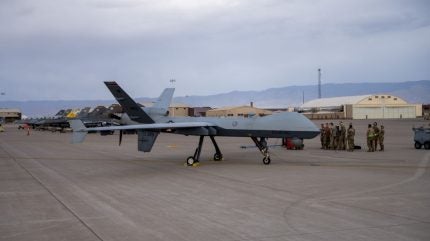
The third iteration of Project Iron Agility, a training exercise, was launched at US Air Force’s Holloman Air Force Base (AFB) to bolster the deployment readiness of airmen.
Over a three-week period, the deployment exercise will involve F-16 Fighting Falcons, MQ-9 Reapers, and the 49th Logistics Readiness Squadron, with the 49th Maintenance Group spearheading the initiative.
The objective of Project Iron Agility is to replicate deployment conditions and real-world operational scenarios.
This aligns with the Agile Combat Employment (ACE) concept, which underscores the necessity for rapid adaptability and mobility, ensuring that the US Air Force can relocate operations swiftly in response to various threats.
US Air Force Technical Sergeant and 9th Aircraft Maintenance Unit specialist section chief Dallas Harlan said: “Agile Combat Employment is about more than just Air Power.
“ACE is about ensuring that everyone in the chain of command can step up, take control, and make decisions quickly, all while maintaining seamless communication and recognising that the team dynamic is everything.”

US Tariffs are shifting - will you react or anticipate?
Don’t let policy changes catch you off guard. Stay proactive with real-time data and expert analysis.
By GlobalDataProject Iron Agility comprises three phases: academic, planning, and execution.
The academic phase uses the Kingfish ACE simulation to challenge airmen to adapt to dynamic conditions that reflect the unpredictability of combat.
In the latest iteration of the exercise, real-time injects or immediate impact drills were introduced during the execution phase for the first time.
These drills simulate unforeseen challenges that airmen may encounter while deployed, requiring them to reassess strategies, collaborate on decision-making, and perform rapid risk assessments under the pressures of real-world operations.
The exercise includes the integration of MQ-9s, which is said to play a role in intelligence, surveillance, and reconnaissance, alongside F-16 Fighting Falcons.
Harlan said: “The MQ-9s are agile and can perform both intelligence, surveillance and reconnaissance and combat air support missions without risking manned aircraft.
“We’re planning for the smallest, most effective footprint, and this exercise combines skills from different Air Force Specialty Codes while streamlining responsibilities so we can adapt quickly if something goes wrong.”
Additionally, logistics teams ensure smooth deployment processes from assembling supply packages to establishing communication networks.
This collaborative approach enhances the team’s cross-functional capabilities and is in line with the ACE concept.
Participants trained under Project Iron Agility gain the ability to assume diverse responsibilities.



